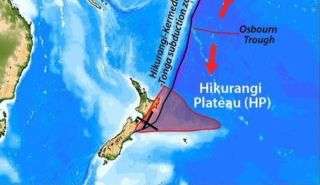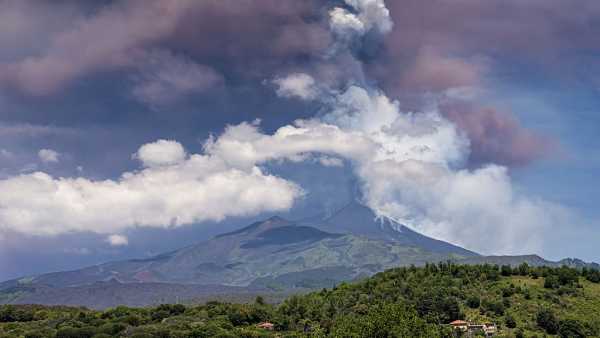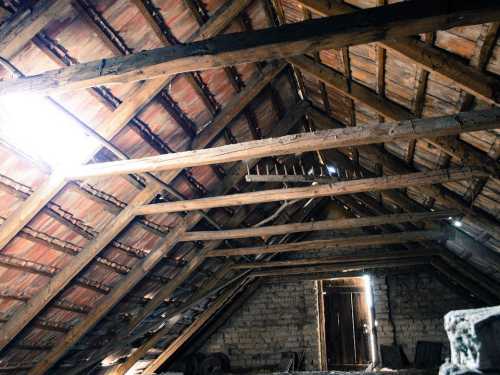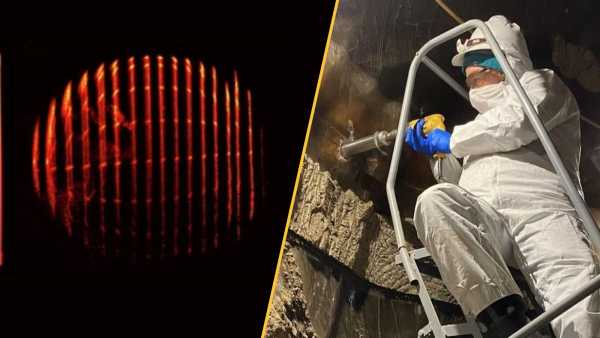
The undersea Hikurangi Plateau (outlined) has a greater area than the entire New Zealand mainland.
About 120 million years ago, a gargantuan blob of hot rock detached from the edge of Earth’s core and oozed up toward the planet’s surface. Today, a huge chunk of that blob — or “superplume,” as geologists call it — may be lurking off the coast of New Zealand, new research suggests.
In a study published May 27 in the journal Science Advances, researchers measured the speed of seismic waves traveling through a layer of Earth called the mantle that sits between the planet’s crust and outer core. They focused on Hikurangi Plateau — a vast, triangle-shaped chunk of volcanic rock located about 2,000 miles (3,200 kilometers) beneath the top of the South Pacific Ocean, just off the coast of New Zealand’s North Island. The team found a match between the seismic waves traveling through that chunk and those traveling through two other nearby volcanic structures.
According to the study authors, it’s likely that all three of these underwater structures were once part of the same gargantuan mega-plateau, formed more than 100 million years ago during the largest outpouring of volcanic material in Earth’s history.
“The associated volcanic activity may have played an important role in Earth history, influencing the planet’s climate and also the evolution of life by triggering mass extinctions,” study co-author Simon Lamb, an associate professor at Victoria University of Wellington in New Zealand, said in a statement. “It is an intriguing thought that New Zealand now sits on top of what was once such a powerful force in the Earth.”
A lava blob legacy
According to Stern, mantle plumes form when huge “lava lamp blobs” of hot, buoyant rock break away from the boundary where Earth’s mantle meets the outer core, then rise thousands of miles up toward the surface. While most of these blobs get caught in the mantle, smaller chunks continue to rise upward, gradually melting as pressure decreases and finally erupting at the surface through volcanoes.
Geologists suspect that mantle plumes are responsible for some of the largest volcanic hotspots on Earth, including the Hawaiian-Emperor seamount chain, the long conga line of dead and active volcanoes stretching from the Hawaiian Islands to the Pacific coast of Russia. (The chain is also home to the single largest volcano on Earth.)
But the mantle plume that welled up under the South Pacific 120 million years ago may be the world’s largest, the researchers wrote, if the fragmented plateaus it left behind are any indication. The Hikurangi Plateau near New Zealand, for example, covers an area of approximately 150,000 square miles (400,000 square kilometers), making the submerged structure nearly twice as large as the New Zealand mainland. If it was once part of an even larger mega-plateau along with the Ontong-Java and Manihiki Plateaus, the researchers reasoned, the three structures must share similar rock properties, both above and below the seafloor.
This illustration shows how the three volcanic plateaus once fit together (A), and what the gargantuan mantle plume beneath them looked like when it first formed (B) and eventually collapsed (C).
To test that theory, the team measured the speed of seismic waves traveling under Hikurangi. Using data obtained from earthquakes and controlled undersea explosions, the team found that seismic waves traveled horizontally through the rocks at nearly 6 miles per second (9 km/s), roughly a mile per second faster than the average global speed at which seismic waves travel through the mantle.
Strangely, though, seismic waves moved much more slowly when traveling vertically upwards beneath the plateau. These speed characteristics are indicative of an ancient mantle superplume that has begun to collapse, the researchers wrote — and that strange relationship between vertical and horizontal wave speeds perfectly matched the wave speeds below the Ontong-Java and Manihiki Plateaus.
Related: In Photos: Ocean Hidden Beneath Earth’s Surface
According to the researchers, these findings suggest that the three big, volcanic plateaus in the South Pacific are indeed broken pieces of one enormous whole, laid down by the single largest superplume ever detected on Earth. In its original form, that ancient mega-plateau — known as the Ontong-Java-Manihiki-Hikurangi Plateau — would have covered about 1% of the planet’s surface, with an area about half as large as the continental United States, the study found.
“Subsequently, the motion of the tectonic plates broke up this plateau, and one fragment — today forming the Hikurangi Plateau — drifted away to the south,” lead study author Tim Stern, a geophysicist at Victoria University of Wellington, said in the statement.
Hopefully, Stern added, the strange seismic wave speed signature linking these three plateaus could be used as a “fingerprint” to identify other scattered fragments of the once-giant superplume.
Sourse: www.livescience.com





